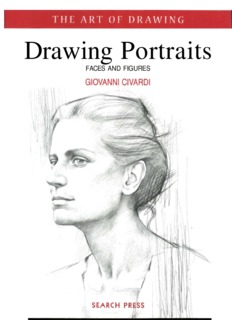Drawing Portraits PDF Free Download

Drawing Portraits Faces And Figures
Step 1. The artist begins drawing the eye by indicating its basic outline with a few simple but carefully placed lines.
He suggests the corner of the eye socket along the entire upper and lower lids, as well as the browbone and side of the nose. At this stage, the iris is just a circle.
Study the contours of the inner edges of the eyelids. Starting from the outer corner, the top lid follows a long, flat curve and curves slightly downwards towards the inside.
The lower lid does just the opposite, starting at the inner corner as a long, flat twist and then curving up at the outer corner.
Step 2. Pressing the tip of his pencil harder, the artist goes back to the casual guidelines of Step I to refine the shape.
The angular lines of Phase I become rounder and more rhythmic. Eyes appear more alive. The shapes of the eyelashes are more clearly defined.
It is equally important to remember that the upper eyelid always overlaps the iris, thereby cutting off part of the circle. The lower eyelid touches the iris but does not overlap it too much.
Step 3. After drawing the shapes more precisely, the artist now begins to block out the tones with broad, smooth strokes.
Tones are actually groups of parallel strokes, which you can see most clearly in the tone of the iris and the shadows inside the eye socket.
The artist suggests the dark spot of the pupil, and he carefully draws the shadow that falls on the iris of the upper eyelid and the white of the eye.
He points to the shadow in the corners of the lids and on the underside of the lower lid.
photography
Photography is useful for recording spontaneous and fleeting images of the subject, for having a reference point when it is not possible to organize meetings, and for photographing children.
Take the pictures yourself (modern automatic cameras make this easy, even if you’re not an expert) as they should be a word of reference rather than images to be passively copied.
Allow for perspective distortion and, to avoid or minimize this, don’t get too close to the subject. Use natural light if possible and avoid flash which is unsuitable for portraiture.
Sketch
Get in the habit of making lots of small sketches (especially if you’re working from life) to study the main lines of the face and figure of the subject you’re painting.
Walk around your subject to assess the best composition, most suitable lighting, most convenient dimensions, etc.
These sketches, even if made quickly, require careful observation, almost a commitment to ‘discovering’ the aesthetic possibilities offered by the model.
Perhaps a successful picture depends on them.
When you become more experienced at drawing a face, you may want to start drawing it; It will then be useful to have a more complex preliminary study than the sketches, to help you sort out any aesthetic problems and to note down all the information you need for the final work.
enlarging
Whether you are planning an accurate drawing, or you are attempting to paint a color portrait, you will need to trace the outline onto a fixed support (paper, canvas, card, etc.) that will serve as the basis for the work. will work as
To this effect, you can, at least in the beginning, take advantage of several tools to easily enlarge a sketch or even a photograph to the desired dimensions.
You can use a simple slide projector to magnify the image on the support and trace the main outline of the face or figure.
Alternatively, you can use an episcope: an optical instrument that allows you to magnify and project images from opaque supports (photographic prints, sketches or small photocopies of paintings and drawings, etc.).
These are practical tools, almost ‘tricks’ that can even harm one’s artistic development if one becomes dependent on them.
Therefore, more appropriate is the ‘grid of squares’ method, which is well known even at the school level.
Draw a grid of squares on the image you want to enlarge (be it a picture or a photo) and then transfer the same grid, with the same number of squares, to the larger surface.
You can then easily move the strokes to different sections while keeping them in proportion.
work environment
If you have your own studio, or at least, a room in the place where you live and you are determined to dedicate yourself body and soul to portraiture, you will find some furnishings useful.
For example: a chair, an armchair or a small sofa on which a person can feel comfortable and comfortable while posing; a lamp that will allow you to adjust the intensity of the light so that the model is properly illuminated; A radio or a small TV to lighten the load for your occupant (and for you).
Remember to take frequent breaks and take advantage of these intervals to study your subject in different poses and poses.
| Writer | Giovanni Civardi |
| Language | English |
| Pages | 66 |
| PDF Size | 5.2 MB |
| Category | Art |
| Credit/Sources | archive.org |
Drawing Portraits With Faces And Figures Pdf Free Download
